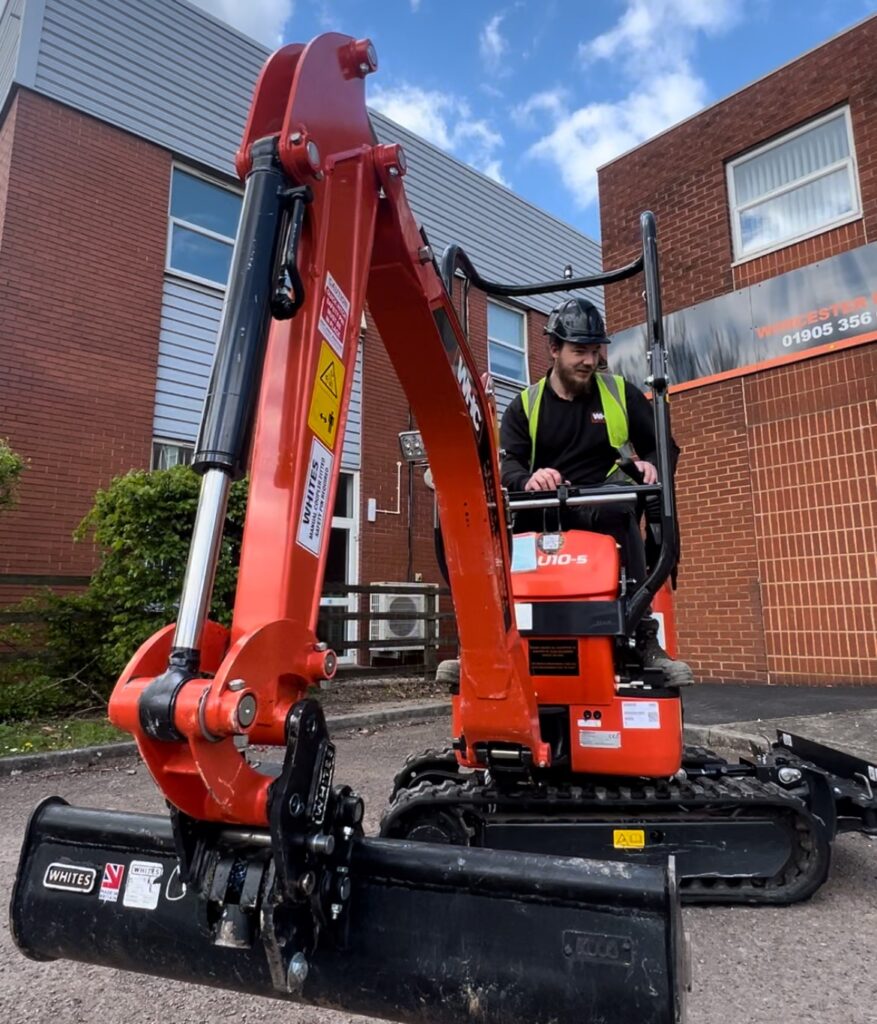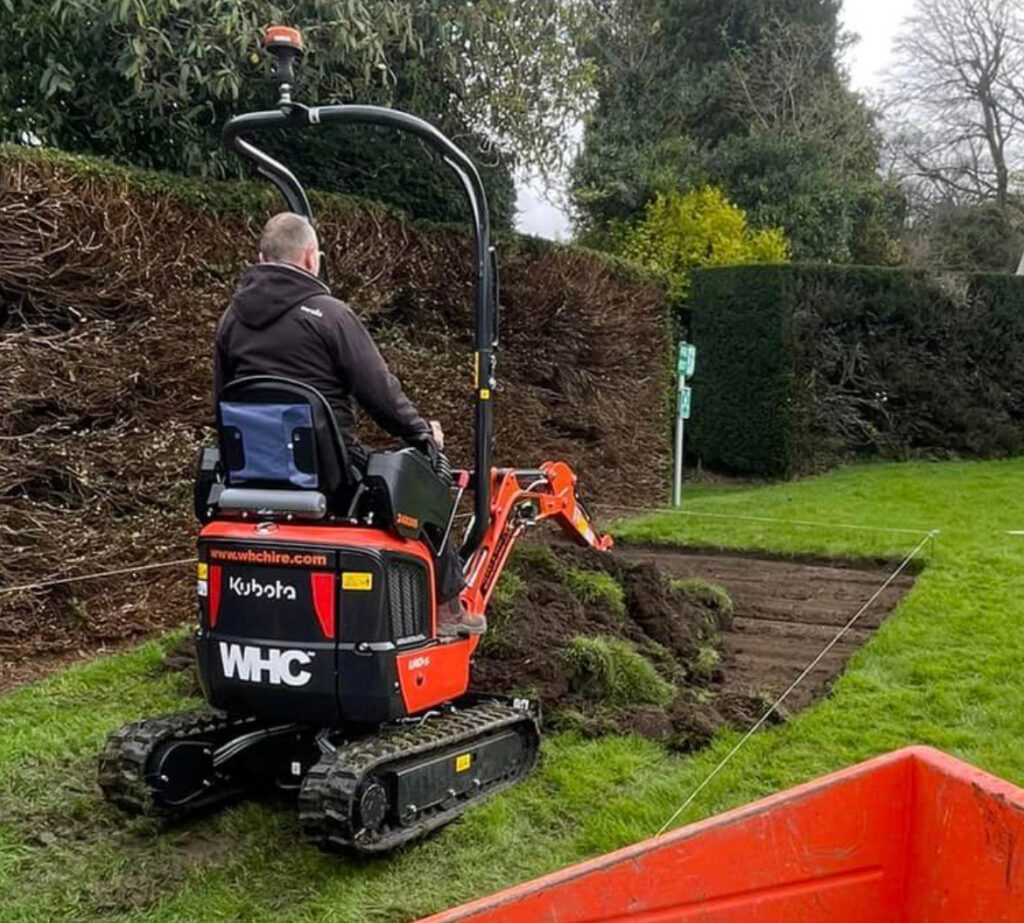Micro Vs Mini Digger for Garden Projects – Which One Fits Your DIY Needs
Using a digger for a garden project can be a highly effective and efficient way of quickly reaching your desired result. Whether you are doing a spot of landscaping, installing foundations for a new outbuilding, or completely redesigning your outdoor space, a digger can be a trustworthy companion to get the job done. One of the hardest decisions you will make will be choosing the right machine to get started. Correct digger selection is crucial to all types of DIY tasks. Done right, these machines will become your biggest asset. If done wrong, you could get yourself stuck in a pickle. In this article, we’re comparing everything you need to know about Micro vs Mini Digger for garden projects. Therefore, when the time comes to choosing the right equipment for your task, you’ll have no hesitations about picking the right companion. Let’s get stuck in.
Understanding Micro Diggers

Micro diggers are the smallest excavating type of machines you can expect to hire for a garden project. Also known as compact excavators, doorway diggers, 0.8T excavators, these machines are designed for manoeuvrability and accessibility in tight spaces, making them ideal for small-scale garden projects.
These small digging machines are characterised by their compact size and weight. Allowing them to navigate through narrow pathways and confined areas with ease. Despite their overall size, these earthmoving machines pack a punch to the most common garden project tasks. The engine, at the heart of the digger, delivers impressive power and digging force for a machine of its size.
Advantages for garden projects
For DIY enthusiasts, tackling garden projects such as landscaping, trenching, and earthmoving tasks, with a micro digger has a wealth of advantages. Their compact design enables them to access tight corners and spaces where larger machinery would struggle. Whether you are digging holes to plant trees, installing new footings or drainage, the micro digger can offer sufficient precision and control necessary to complete your garden project task.
Some limits to consider with micro diggers
Despite their benefits, it is worth noting that micro diggers do have some limitations that you should consider. Where they strive in tight access spots, they offer a reduced dig depth, lift and bucket capacity, than you will receive on a larger designed excavator. This makes them less suitable for large-scale garden projects and earthmoving tasks. In addition, their lightweight design may offer less stability on uneven terrains.
Micro diggers are an invaluable tool to tackle a wide variety of garden construction. They offer an ample amount of versatility, manoeuvrability and precision, to help DIYers with small landscaping, trenching and excavation. Nevertheless, it is essential to assess this equipment’s limitations, particularly its dig depth and stability, to ensure it is suitable for the task at hand. Working closely with your plant hire supplier will aid your safety when considering this type of machinery.
Exploring mini diggers for garden projects

Mini diggers, also known as mini excavators, occupy the sector between Micro diggers and their larger counterparts. With a bigger footprint, greater power, and increased versatility, these DIY digging machines offer plenty of performance to tackle most garden projects. Let’s look at the advantages of choosing one of these machines for your task.
Mini diggers normally weigh between 1.5 tonnes and 3 tonnes, making them far larger and more superior in terms of specifications than a micro excavator. Their powerful, highly efficient engines provide the required strength to tackle the job at hand. This allows users to complete their tasks with efficiency and with ease.
Advantages of choosing a mini digger
Mini diggers are best suited for DIY projects that require a balance of power, manoeuvrability and increased dig depth. They are ideal candidates for digging trenches for foundations, clearing land, grading terrain and general building work. Their increased size and specifications make them suitable for medium DIY garden projects while maintaining a compact size to navigate smaller, tighter spaces.
One of the key benefits of using a mini digger for a garden project is its versatility. With a wide range of attachments that operate through the equipment’s auxiliary hydraulic system, these machines can easily adapt to different tasks and terrains with ease.
Limitations of a mini digger
Whilst these machines offer a huge range of versatility, strength and manoeuvrability, they also have limitations. At the same time as being highly compact, mini diggers are larger than their micro digger cousins. Therefore, for tight-access garden projects, they may be too big.
Further is their lifting capabilities. It is a common misconception that these machines can lift a huge amount more than micro excavators. The truth is, that they are not suitable for lifting anything over 1 tonne in weight at full reach. (Designs may vary) If there is a specific weight you wish to lift with an excavator, you should consult your plant hire supplier to help.
Why mini diggers are a great fit for garden projects?
Mini diggers are a highly versatile and powerful option for DIY garden projects, offering balance, power, precision and detailed manoeuvrability. Choosing a digging machine like this will grant a wide range of benefits to your project. Nevertheless, you should always consider your lifting, reach, dig depth and access requirements to ensure you choose the right machine for the job. Unsuitable equipment selection can lead to compromising your safety and damaging the equipment. As a comparison, let’s now have a closer look at a micro and mini digger side by side.
Micro Vs Mini Diggers: Comparing features and performance
Comparing equipment is essential to ensuring that you choose the correct excavator the first time around. Remember if you are ever unsure, you should work closely with a plant hire specialist to get you started. Nevertheless, let’s put these two machines side by side to compare and contrast the differences between them.

Dig Depth
In terms of dig depth, the mini digger offers the larger of the two, sporting 2740mm. Making it favourable for deep excavation tasks such as digging trenches for outbuilding foundations or footings.
Width
The Micro digger offers a far more compact design (750mm wide) than a mini digger, meaning it can work in tighter spaces. For some, this is essential for their garden project. We’d highly recommend that you bear this consideration in mind during the planning stage.
Cabin
One of the more obvious features is the operator’s cabin. Most mini diggers are equipped with a full FOPS (fall-on protection structure) & ROPS (roll-over protection structure). In this instance, in the form of a cabin. Micro diggers only tend to offer a ROPS bar as shown in the photo above. You should always take the necessary safety precautions when choosing suitable machinery for your task.
Weight
One of the biggest differences between these two machines is their weight. The micro digger’s operating weight is far less than the 3T excavator. This is essential to be aware of when choosing your equipment. Using overweight machinery can damage the existing ground you are working on. (In some cases, this is vital).
Max Lift Capacity
The final comparison is the lifting capacity. In this instance, the mini digger offers far more lifting capacity compared to a micro digger. However, as you’ll see, it may not be suitable for lifting extremely heavy objects. If lifting is crucial to your garden project, you may need to seek an alternative piece of equipment.
After comparing micro vs mini digger, it’s evident that these two pieces of equipment excel in different situations. When space and access are significant considerations, the micro digger emerges as the favourable choice. Its compact size and manoeuvrability make it ideal for navigating tight spaces and confined areas typical in many garden projects.
However, for those with the flexibility to opt for a larger machine, the mini digger offers additional benefits worth considering. With increased dig depth, lifting capacity, cabin protection, and stability, the mini digger becomes a compelling choice for projects where these features are essential.
In essence, the choice between a micro vs mini digger boils down to the specific requirements of your garden project. Let’s now have a look at the questions you should consider to choosing either a micro or mini digger.
Questions to consider when choosing a Micro or Mini Digger

If you still find yourself stuck choosing between a micro vs mini digger, then to help, here are some quick-fire questions you can ask yourself to get the right machine for your DIY garden project.
Scale of project
The scale of your project is important to consider. Smaller earthmoving tasks can be conducted by Micro diggers. Whereas medium-large garden projects will be better suited with diggers with larger reach, dig depth, bucket and lift capacities. Meaning you can do more at one time.
Terrain
The terrain of your task is essential to consider. Some terrains are very uneven and therefore will require a heavier machine to safely work. However, in other cases, you may be working on sensitive ground or having to track the digger through a building to get to the working area. Choosing a digging machine suitable for the terrain will only enhance your safety and ground disruption.
Obstacles you are working with
Another consideration is the obstacles you may be forced to work around within your working area. Picking a suitable excavating machine for the potential hazards ahead, can avoid damage costs and unwanted inconveniences.
Dig depth and reach you require
You always need to ensure the micro or mini digger is suitable for the task at hand. During your planning stage, you should ensure the equipment can reach and excavate at the required depths you need. Incorrect equipment selection can lead to additional equipment spend and potentially put you at risk of danger.
When comparing a micro vs mini digger for a DIY garden project, you must consider the scale, terrain, obstacles and specifications of the equipment you are planning to use. In doing so you can safely complete your task with ease and reduce the risk of accidents occurring. We highly recommend that if you are ever unsure, always consult a reputable plant hire company to help you select the correct machine for your project.
Conclusion
So, which digger is right for your garden project? It all comes down to your unique needs and circumstances. If you’re facing tight spaces and access constraints, the nimble micro digger could be your saving grace, offering unparalleled manoeuvrability to get the job done.
However, if you have the luxury of space and seek added power and versatility, the mini digger might be your ticket to enhanced dig depth, lifting capacity, and overall project efficiency.
Remember, the key to making the best decision is understanding your requirements and prioritizing functionality over everything else.

Ready to equip yourself with the perfect digger for your garden endeavour? Reach out to WHC Hire Services today. Our team is standing by, ready to assist you in finding the ideal solution for your project needs.
Don’t let uncertainty hold you back— contact us now and let’s turn your DIY dreams into reality!”

